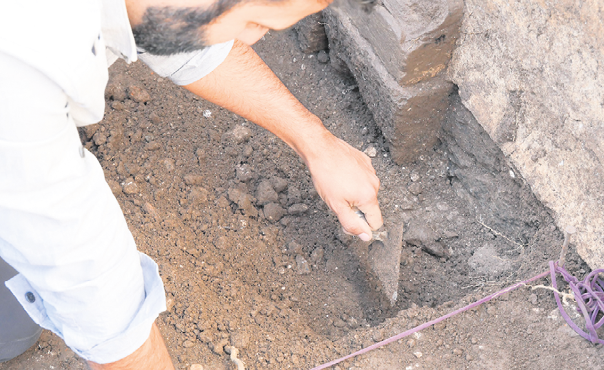
The General Directorate of Cultural Heritage, in collaboration with the Department of Cultural Heritage of the City Council of La Orotava, has financed several surveys in the church of San Francisco, located in the historic center of this Villa, to try to locate and corroborate the archaeological potential of the old convent of San Lorenzo.
Excavations began in early November last year and ended in mid-December. Since then, the Prored team, led by Hacomar Ruiz, has been analyzing the materials and architectural evidence to confirm that the excavated space contained the remains of the convent, which disappeared in 1801 as a result of a fire.
The flames consumed buildings, images, furniture and documents. Only the stonework façade of the church and some works of art were saved from the fire, which is why this archaeological investigation is decisive in recovering the almost three centuries of history of this enclave. Its historical importance lies in the fact that El Escorial de Canarias, as Viera y Clavijo called it, was one of the first Franciscan convents after the conquest of the Canary Islands, in fact, it was the first monastic foundation in the northern municipality, for which this institution is key in the original organization of what would be the later city.
In 1519, the Franciscan friars constituted the convent of San Lorenzo at the initiative of the conqueror Bartolomé Benítez de Lugo, nephew of the Adelantado Alonso Fernández de Lugo. This monastery once had 60 monks and served as the chapter house for the province of the Canary Islands.
Among the objectives that are intended to be achieved with this first intervention is to provide archaeological evidence if the old monastery continued its orientation towards the south and “identify what could have been the original floor of the convent that disappeared in the 19th century,” explains Ruiz, co-director of the draft.
As has been confirmed, “the leading role of the church and Christianization was fundamental in the conquest and colonization of the Canary Islands”, affirms, for her part, the general director of Cultural Heritage of the Autonomous Government, Nona Perera, who adds that ” the establishment of temples and religious orders supported a model of conquest that we need to know so that the past of the Canary Islands has fewer shadows and, for this, it is essential to study these enclaves”. For the Councilor for Cultural Heritage of La Orotava, Delia Escobar, with this first phase “historical justice is done in an enclave that was fundamental for the development and evolution of the municipality three centuries ago,” she declares.
According to the main hypotheses, the convent of San Lorenzo was located in what is now the Hospital de la Santísima Trinidad and the church of San Francisco, but its extension was much larger, occupying approximately 2,600 square meters.
Remains of the original construction
As it is such a large area, four surveys were carried out in an unbuilt space attached to the Church, where vestiges that could have been part of the original construction were found. “The documentation tells us that the old convent was in this area and with the archaeological intervention, the trail of construction elements that already indicate the architectural importance of this space with a Corinthian column or a stone arch is being followed”, Ruiz advances.
Through the Archeology of Architecture and the photogrammetric record, “different wall units and construction elements can be recognized that explain the architectural evolution of this space,” says the archaeologist, such as landslides, remodeling, subsequent construction, reoccupation, structures combustion, among others.
The study of the sediments contributes to deciphering human behavior in relation to that place, since each archaeological stratum preserves different historical events superimposed on each other, and, therefore, each one contains varied information about the functionality of the convent.
The recovered sediment has been sifted to ensure the maximum recovery of the archaeological material, which includes fragments of vessels, glass and metal elements, various fragments of fauna, but also debris from the time when the hospital was in operation.
A column of Corinthian order that was managed to reach the base
In this first phase, many remains and hospital waste were found, as well as scrambled remains. A second intervention is essential to be able to relate the different stratigraphic units and the registered construction elements. Among them, there is a Corinthian column that was already known, but it was possible to reach the base, and a stone arch. Both point out that it is, possibly, in front of a nave of the convent and that is why the ideal would be to open up the entire area in order to try to connect all the architectural material that appeared.















